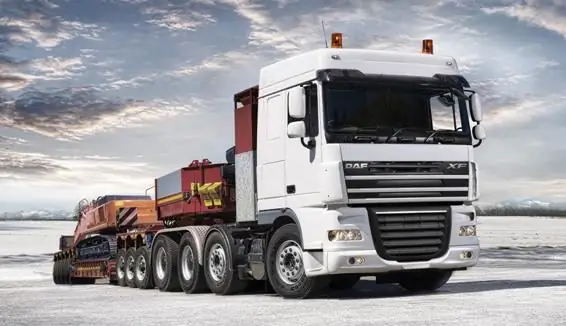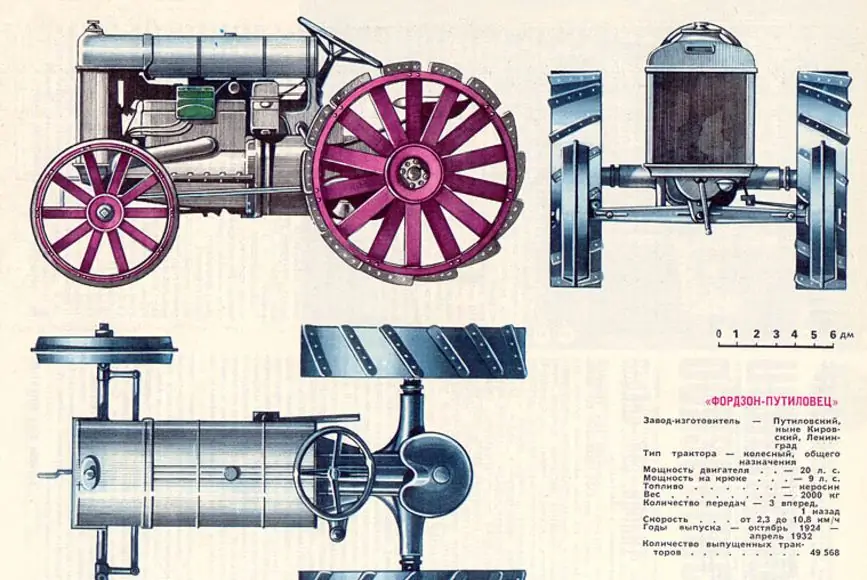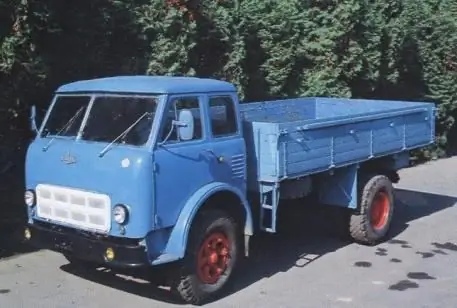2025 Author: Erin Ralphs | [email protected]. Last modified: 2025-01-22 21:14:11
In the mid-thirties of the last century, the Red Army began to be equipped with large-caliber artillery guns of the appropriate power. The task of creating heavy tractors capable of showing a tractive force of at least 12 t / s, transporting a trailer weighing 20 tons at a speed of at least 30 km / h has become urgent. In addition, the equipment should be equipped with a winch designed to evacuate tanks weighing up to 28 tons. The Voroshilovets tractor was developed specifically for this purpose, its power and weight were compared with similar parameters of the existing heavy armored vehicles.

Design
Taking into account the tasks set, the GAU together with the GABTU took up the development of a suitable modification. The design of the Voroshilovets heavy artillery tractor began in 1935 at the Kharkiv Locomotive Plant. Comintern.
A huge team of engineers of the special department "200" (SRO) worked on the creation of the legendary sample. Among the main designers and developers:
- Ivanov D. (responsible forlayout).
- Libenko P. and Stavtsev I. (motor part).
- Krichevsky, Kaplin, Sidelnikov (transmission group).
- Efremenko, Avtonomov (running elements).
- Mironov and Dudko (auxiliaries).
- Chief designers - Zubarev N. G. and Bobrov D. F.
The created group worked quickly and hard, often staying overtime. All technical documentation was made in just a few months and was ready by the end of 1935
Choice of power plant
Initially, the design of the Voroshilovets tractor was based on an experimental tank diesel engine BD-2. The power of the V-shaped installation with a dozen cylinders was 400 horsepower. The body of the motor is made of aluminum alloy, the injection system is of direct type.
In parallel, the factory department "400" under the direction of K. Chelpan worked on the refinement and adjustment of the power unit. The first two prototypes of the equipment were built in 1936. For 24 months, the Voroshilovets tractor participated in factory and field testing.
In the spring of 1937, one sample made a successful march to Moscow and back. In the capital, the equipment was shown to the higher leadership, including Marshal K. Voroshilov. Everyone was satisfied with the car, it made a positive impression and was unanimously approved for serial production.
In the summer of 1938, a new derated tank engine was tested, which received the name V-2V for the equipment in question. The engine showed a high level of reliability desiredperformance and economy. The unit started up without problems and functioned stably on variable ranges. Thus, the go-ahead was given to the beginning of the mass use of light and fast transport diesel engines of the B-2 configuration. They were installed on medium and powerful tractors for the next 40 years. On the basis of the technology in question, in 1937, an experimental model of the rotary high-speed excavator "BE" was designed.

Description of the tractor "Voroshilovets"
The machine had a standard layout with a front lowered engine placement, the subsequent location of the transmission unit, winch, drive rear main stars.
Due to the decent length and moderate height of the motor, it was rationally installed under the cabin floor. This design was used on many other tractors. Access to the maintenance of the system was carried out through the protruding sides of the hood and special hatches.
The diesel plant was equipped with four air-oil filters, a starter unit from a pair of electric starters, a spare pneumatic aircraft-type start system (worked from compressed bottled air). At low temperatures, this design failed. In this regard, a preheater was mounted on the Voroshilovets heavy tractor. The radiator sections were assembled from tubular elements, the six-blade fan was equipped with a belt drive, synchronously damping the rotating vibrations of the motor.
Dry-type lubrication system with separate reservoir does notnarrowed the maximum angle of roll and lift of equipment. The main clutch is a multi-disk tank-type dry part with pedal control. A cardan multiplier shaft was aggregated with it, which allows doubling the number of gears in the transmission, slightly unloading it and bringing the total power range to 7.85. The four-speed automotive configuration gearbox was made in one bundle with a conical pair. The assembly included multi-plate clutches. The brake system is made on the principle of a tank analog of the BT, which was produced by the same 183rd plant in Kharkov. At first, the transmission often failed, because the designers were only at the beginning of the path to optimize such powerful and rigid power plants.

Chassis
Artillery tractor "Voroshilovets" has a base placed on eight paired road wheels. They are reduced to balancing-type bogies with lever-spring stabilizers on the suspension. The design provides good ride smoothness, as well as an equivalent transformation of loads on the tracks, which had a positive effect on the cross-country ability.
The speed function was determined by rubber bands and wheel guides. However, the node's scope of maintenance was quite extensive. The fine-grained caterpillar with small tank lugs had insufficient interaction with the ground. This was especially observed on icy and snowy surfaces. The part was also poorly cleaned of dirt.
A similar problem affected not only the Voroshilovets tractor, but also all pre-war high-speed analogues. For a long time, designers were unable to combine the necessary speed parameters with decent traction characteristics of caterpillars. In this regard, the technique in question was not able to maximize the reserve of its power. The traction force for adhesion to the soil did not exceed 13,000 kgf, although according to the engine values it could reach almost 17,000 kgf.
Additional hooks for the soil made it possible to improve the properties of the tracks, but they served no more than 50 kilometers. The reversible winch was located in the middle part under the body, equipped with a horizontal drum mechanism, on which a 23 mm cable 30 meters long was wound. The steel rope protruded forward on the rollers, which made it possible not only to pull up loads and trailers, but also to pull the machine out.

Frame and electrical equipment
This assembly of the Soviet Voroshilovets tractor is a welded configuration of a pair of longitudinal channels. Reinforcement is made in the form of many kerchiefs, crossbars and platforms. The lower part of the frame was closed with removable sheets. At the rear there is a swivel hook with a detent and buffer springs designed for increased traction.
Technique was well equipped with electrical equipment. The system included a 24-volt generator, four batteries, a complete set of lighting elements and signaling devices. There were more than 10 on the panel in front of the drivercontrol dials, including hours. The cabin was taken from the ZIS-5 car, it was radically re-equipped and enlarged. The ventilation process and communication with the maintenance crew was carried out through a pair of hatches in the rear of the cabin.
Two fuel tanks with a capacity of 550 liters, battery, oil reserve, fire extinguishers, and tools were installed on the front segment of the capacious cargo platform. The personnel were located on three transverse removable seats and one additional counterpart. The rest of the space was intended for ammunition and impressive artillery equipment. A removable tarpaulin awning was mounted on top.
Tests
Heavy artillery tractor "Voroshilovets" in the summer of 1939 was tested at an army tank training ground in the Moscow region. The vehicle lived up to expectations, showing good results in towing the largest artillery mounts and all types of tanks. Among the systems tested for transport:
- T-35 tank.
- 210 mm gun with separate carriage and barrel.
- 152 mm 1935 guns.
- Howitzers of 1939 (caliber - 305 mm).
The design of the Voroshilovets tractor made it possible to easily overcome fords up to 130 centimeters deep, ditches - up to one and a half meters, lifting with a load of 18 tons - up to 17 degrees. The maximum speed was 42 km / h. On the ground with a maximum load, this figure varied from 16 to 20 km / h. This parameter was higher than any other analogue.
A similar result was achieveddue to high power density and improved suspension technology. Equipped with an economical diesel engine, the car withstood the daily march without stopping without refueling. As a fuel, not only diesel fuel was used, but also gas oil, or a composition that included a mixture of kerosene with engine oil. On the highway, the cruising range with a load was up to 390 kilometers. Fuel consumption (hourly setting):
- With loaded trailer - 24 kg.
- Without tow hitch - 20 kg.
- Basic load - 3 t.
Artillerymen received equipment with sufficient engine power and high payload. Traction effort also suits customers completely. Even in a drought, this indicator was limited only by the grip of the tracks with the soil when the potential was realized almost to the full selection of road clearance.
Technical characteristics of the Voroshilovets tractor
The following are the main parameters of the army vehicle in question:
- Length/width/height - 6, 21/2, 35/2, 73 m.
- Curb weight without load - 15.5 t.
- Road clearance - 41 cm.
- Platform load capacity - 3 t.
- Cab capacity is three people.
- Towed hitch weight - 18 t.
- Seats in the back - 16 pieces
- The speed limit on the highway is up to 40 km/h.
- Cruising range with loaded trailer - 270 km.
Disadvantages and difficulties in maintenance
Description of the design of the tractor "Voroshilovets" will be incomplete without mentioning the negative aspects. Serious shortcomingswere discovered during the operation of the machine. The caterpillar was not entirely successful. It showed poor traction, and also often fell off, especially when wet snow stuck in the grooves of the drive sprockets.
The main clutch could fail after 250-300 hours of operation. At the first releases of equipment, breakdowns of the driven shafts and gears of the multiplier mechanism were often observed, wear of the bearings on the final drive elements was noted.

Other "troubles" specific to the Voroshilovets artillery tractor:
- Leaking oil seals (the main headache of KhPZ production units).
- Deformation of pipelines under the influence of vibration from a powerful engine.
- Deflection and shearing of the lower frame skin as a result of driving on rough roads and potholes. This minimized the site's already weak security.
- Extension of trailer hook when generating excessive traction.
- Inconvenient control and use of the winch.
Difficult moment was the cold start of the diesel engine, especially at temperatures below 20 degrees. It happened that the process of starting with repeated heating, spillage of working fluids dragged on for several hours.
In such cases, electric starters did not help, and the use of a backup air start sometimes gave the opposite result: the compressed air supplied to the cylinders expanded, supercooled to the formation of frost, which made it impossible to obtain an operating temperature of 550degrees required for spontaneous combustion of fuel.
Despite the many positive characteristics of the Voroshilovets tractor, the car showed intensive and irreversible wear of the chassis hinges, including the bushings of the suspension axles. Often this was due to poor dirt protection and insufficient lubrication. Particularly vulnerable were primitive labyrinth seals for bearings of road wheels, safety rollers and guide wheel elements.
To reduce output and prevent deformation of parts when moving through deep liquid mud, in which bearings and rollers were often completely dipped, they had to be completely disassembled, washed and well lubricated. Such a procedure was required to be carried out very often, which significantly increased the complexity of servicing equipment in the field. Oddly enough, but at the factory, the sealing of bearing blocks was practically not paid attention. The same problem was transferred to the T-34 tank. All these disadvantages were further aggravated by the difficulty of access to units and mechanisms, which complicated the repair and maintenance of the vehicle directly in the military unit. Due to the presence of a lot of shortcomings, the release of the modifications in question did not continue after the war.
Operation
In wartime, the Voroshilovets tractor, the photo of which is presented in this article, was effectively operated on all fronts. The main task of the machine is heavy transport work to tow high-powered artillery. In this segment, said technique was unparalleled.
With all availableshortcomings, the fighters evaluated the work of the tractor exclusively in a positive way. At that time, not a single army in the world had such a powerful transport. Even the Germans respected the captured "Voroshilovtsy", calling them clearly and clearly - "Stalin". Official name - Gepanzerter Artillerie Schlepper 607.
The equipment in question did not remain without work in tank units. However, every year the operation of transport became more complicated. Firstly, work on the model in the design office was stopped. Secondly, there were problems with spare parts that were not produced, not counting the engines. At the same time, a major overhaul of equipment was required every 1200 hours of operation.
In connection with these problems, as well as taking into account combat losses, in September 1942 only 528 units remained in service, and by the end of the war only 336 copies remained in operation. We must pay tribute to the tractors: they steadfastly withstood all the tests and reached Berlin with the Soviet troops, deservedly took part in the Victory Parade. The surviving devices, which had not fully developed their resource, were used for some time for their intended purpose, until they were replaced by analogues of the AT-T brand.

Interesting facts
At the end of 1939, the Voroshilovets tractors were assembled at a speed of up to one and a half cars per day (bench assembly). By the end of the summer of 1941, 1123 units were produced. Then the production facilities were evacuated to Nizhny Tagil.
Even withincreasing the rate of production of such equipment was sorely lacking. In general, from June 22, 1941, the Kharkov plant delivered 170 units of these tractors to the army. Due to the lack of tank diesel engines of the V-2 type, they were delivered primarily to the T-34, there were practically none left for tractors. There were attempts to mount other engines, such as M-17T and BT-7. The designers of the artillery plant in Podlipki planned to redesign the tractor into a self-propelled gun mount with an 85 mm gun. This work was not developed due to the evacuation of the plant.
Modeling enthusiasts and connoisseurs of rare World War II military equipment can assemble a replica of the legendary vehicle with their own hands. For example, kit No. 01573 from Trumpeter 1/35 (Soviet tractor "Voroshilovets") is presented on the market with a set of 383 elements.

It also includes detailed assembly instructions and a decal. The working process is carried out using a special glue. The result will be an exact copy of the vehicle on a scale of 1:35.
Recommended:
IZH-27156: photo, description, characteristics and history of the car

One of the latest models produced by domestic production is IZH-27156. What exactly contributed to the creation of such an amazing utility vehicle? Or, in other words, who pushed the Izhevsk Automobile Plant to release a new production car?
Truck tractor: brands, photos, prices. What brand of tractor should I buy?

Tractor truck - a towing vehicle that works with long semi-trailers. The machine is equipped with a fifth wheel type device with a gripping socket into which the rod of the towed vehicle is inserted
Fordson tractor: photo and description, specifications

Tractor "Fordson": description, specifications, history of creation, features, photo. Tractor "Fordson Putilovets": parameters, interesting facts, manufacturer. How the Fordson tractor was created: production facilities, domestic development
Volvo-A35F mining dump truck: description and characteristics

Today, not a single mining enterprise can do without the use of heavy and productive special equipment, namely mining dump trucks. The Swedish company Volvo does not stand in one place and is gradually developing more and more new truck models that are great for operation in various conditions
"MAZ 500", truck, dump truck, timber truck

The Soviet truck "MAZ 500", the photo of which is presented on the page, was created in 1965 at the Minsk Automobile Plant. The new model differed from its predecessor "MAZ 200" in the location of the engine, which was placed in the lower part of the cab. This arrangement allowed to reduce the weight of the car

